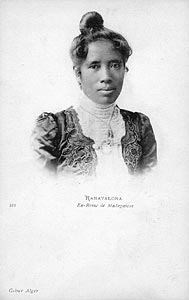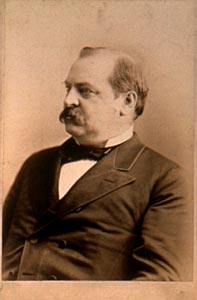
 The
Merina queen Ranavalona III (reigned 1883--96) came to the throne in 1883
at age 18. This was a turbulent time, when Madagascar was at war with
France. The war ended in the peace treaty of 1885 that ceded to France
control over Madagascar's foreign affairs. The
Merina queen Ranavalona III (reigned 1883--96) came to the throne in 1883
at age 18. This was a turbulent time, when Madagascar was at war with
France. The war ended in the peace treaty of 1885 that ceded to France
control over Madagascar's foreign affairs.
During her reign, Queen Ranavalona III tried to thwart both French and British designs to control Madagascar
by turning to the nation's strategic trading partner--the United States--for support. Despite the queen's efforts, her fate was sealed when the French finally invaded and colonized Madagascar in 1896. They abolished the Merina monarchy and exiled Queen Ranavalona III to Algeria, where she died in 1917.

 Grover
Cleveland (1837‚-1908) was the 22nd and 24th president of the United States,
the only president to have served two nonconsecutive terms (1885‚-89,
1893‚-97). He was the first Democrat elected after the Civil War, but
he appealed to both parties with his pledge to fight political corruption
and big money interests. Grover
Cleveland (1837‚-1908) was the 22nd and 24th president of the United States,
the only president to have served two nonconsecutive terms (1885‚-89,
1893‚-97). He was the first Democrat elected after the Civil War, but
he appealed to both parties with his pledge to fight political corruption
and big money interests.
Cleveland was born in New Jersey and raised in upstate New York. As a young lawyer, he became active in politics, serving as mayor of Buffalo and later as governor of New York before being elected president. He died in 1908.

 After
the signing of the first American-Malagasy treaty of 1867, Queen Rasoherina
and Prime Minister Rainilaiarivoy sent gifts of silk cloth to President
Andrew Johnson. In return, the United States government sent gifts demonstrating
the latest technologies and views of American life. These included a Singer
sewing machine with the most up-to-date improvements, a gold pen and pencil
set and a photograph album of American views. The prime minister received
an ornately designed pair of Smith and Wesson revolvers. Both exchanges
demonstrated each nation's conventions of gift giving and diplomacy. After
the signing of the first American-Malagasy treaty of 1867, Queen Rasoherina
and Prime Minister Rainilaiarivoy sent gifts of silk cloth to President
Andrew Johnson. In return, the United States government sent gifts demonstrating
the latest technologies and views of American life. These included a Singer
sewing machine with the most up-to-date improvements, a gold pen and pencil
set and a photograph album of American views. The prime minister received
an ornately designed pair of Smith and Wesson revolvers. Both exchanges
demonstrated each nation's conventions of gift giving and diplomacy.
Pictured above (from top to bottom)
Queen Adelaide receiving the Malagasy ambassadors at Windsor Castle in March 1837
Color photograph of an oil-on-canvas painting by the British painter Henry Room (1802-1850)
Crown © U.K. Government Art Collection
Courtesy Government of the Republic of Madagascar
Cloth (lamba akotofahana) presented
in 1886 by Queen Ranavalona III to President Grover Cleveland
Merina peoples, Madagascar
Late 19th century
Silk, dye
National Museum of Natural History,
Smithsonian Institution, 165,580
As early as 1837, the Merina sent delegations to the powerful nations of Europe to press for guarantees that the island would not be invaded and that Madagascar's independence would be recognized.
Ranavalona III, queen of Madagascar
Photograph by J. Geyser, c. 1900
Collotype
Postcard Collection, MG-15-8
Eliot Elisofon Photographic Archives
National Museum of African Art, Smithsonian Institution
President Grover Cleveland
Photograph probably by B. F. Powelson, c. 1881‚82
Albumen print
Graphics File, Department of Prints and Photographs
National Portrait Gallery, Smithsonian Institution
Malagasy woman using a sewing machine
Photographer unknown, c. 1900
Collotype
Postcard Collection, MG-4-9
Eliot Elisofon Photographic Archives
National Museum of African Art, Smithsonian Institution
|

